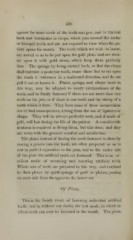Page 462 - My FlipBook
P. 462
158
against the inner circle of the teeth and jaw, and is carried
back and terminates in clasps, which pass around the molar
or bicuspid teeth, and are not exposed to view when the pa-
tient opens his mouth. The teeth which we wish to insert,
are sawed so as to be put upon the gold plate, and are rivet-
ed upon it with gold rivets, which keep them perfectly
firm. The springs, by being carried back, so that the clasps
shall embrace a posterior tooth, cause these last to act upon
the tooth it embraces in a horizontal direction, and do not
pull it out or loosen it. Plates, springs, and clasps made in
this way, may be adapted to every circumstance of the
teeth, and be firmly fastened if there are not more than two
teeth on the jaw, or if there is one tooth and the stump of a
tooth which is firm. They have none of those inconvenien-
ces or bad consequences, arising from the use of ligatures or
clasps. They will be always perfectly neat, and, if made of
gold, will last during the life of the patient. A considerable
neatness is required in fitting them, but this done, and they
are worn with the greatest comfort and satisfaction.
The plates instead of having the teeth fastened to them by
sawing a groove into the teeth, are often prepared so as to
rest in perfect opposition to the gum, and to the under side
of the plate the artificial teeth are fastened. This is an ex-
cellent mode of mounting and inserting artificial teeth.
Whole sets of teeth are prepared in this way, and confined
to their places by spiral springs of gold or platina, passing
on each side from the upper to the lower set.
Of Pivots.
This is the fourth mode of fastening individual artificial
teeth, and is, without any doubt, the best mode, in which ar-
tificial teeth can ever be fastened in the mouth. The pivots


